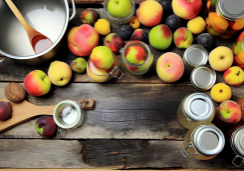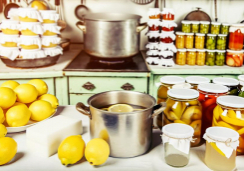Steamy Loaves: Unlock Genuine Home Baking Secrets
Imagine your kitchen as a treasure cave, where the riches of golden, steamy loaves await your masterful touch.
You've dabbled in the alchemy of flour, water, and yeast, but the true secrets to unlocking the full potential of home baking have eluded you—until now. This guide isn't just a collection of recipes; it's a passport to the subtleties that transform good bread into great bread.
You'll learn why diastatic malt powder might just be the unsung hero of your pantry and how to create a steamy haven for your dough to rise to its fullest glory. Consider the frustrations of sunken centers and uneven crusts things of the past as you discover the nuances of timing and temperature.
But where do you start, and how can you ensure your bread will sing with flavor and texture? Stay with me, and let's unlock the oven door to a world where your bread is the talk of the town.
The Science of Steam Baking
Harnessing the power of steam within a Dutch oven, you'll often find your bread bakes into a delectable masterpiece with a perfectly crispy crust. By preheating the Dutch oven, you're setting the stage for a high oven temperature that's crucial for a rapid bread rise.
As you place your dough inside and close the oven door, the contained space traps moisture, creating steam that envelops the loaf. This steam baking technique is essential; it allows the surface to remain flexible during the initial baking period, so the bread can expand freely.
The steam also contributes to forming that coveted crunchy exterior of artisan bread. But to achieve this, timing is key. You'll want to bake for 20 minutes with the lid on, then remove it to let the crust develop color and texture.
Keep an eye on the internal temperature of your bread – it's a reliable indicator of when your loaf has perfectly baked through.
Preparing Your Dough for Steam
Before sliding your shaped loaf into the scorching embrace of a preheated Dutch oven, ensure you've scored the surface with decisive slashes that will guide its expansion into a bakery-worthy spectacle.
With your sourdough starter having worked its magic, it's now time to perfect the art of steam preparation.
When you make the dough, it's not just about mixing and kneading; it's about envisioning the end product. As your dough completes its second rise, the anticipation builds. You're on the cusp of creating something extraordinary, but a heavy bread awaits if you don't handle the next steps with care.
Ensure your dough is ready for this steamy transformation. It should be proofed but still possess the energy to spring up once it hits the high heat. Cover the bowl and let it proof in the fridge if your dough needs more time; a long time at a low temperature can deepen flavors and improve texture.
As you transfer your dough into the Dutch oven, remember that steam is the secret to a glossy, crackling crust. Spritz your loaf lovingly with water, and then seal it under a lid. This humid haven is where your dough will blossom, emerging as a masterpiece of home baking.
Crafting the Perfect Steam Environment
Having prepared your dough with meticulous care, it's crucial to now focus on creating the ideal steamy cocoon within your Dutch oven for that perfect crusty exterior.
Preheating your Dutch oven isn't just a step; it's the foundation of a crispy crust for your sourdough bread. The high heat stored within the walls of the oven mimics a professional baking environment, ensuring your bread dough springs to life the moment you place the dough inside.
Remember, patience rewards the baker. Proofing your dough in the refrigerator overnight may have been a test of your resolve, but it has deepened the flavors, making your efforts worthwhile. As you transfer the dough from the bread machine or grain mill to the blazing Dutch oven, the contrast in temperatures will be the magic that puffs up your loaf.
But don't stop there. Introduce a dash of boiling water into the mix, or create a shallow pool at the top of the dough before you score it. This moisture is crucial during the early baking process.
And when it's time, be brave—turn off the oven and let the residual heat finish the job, giving your bread recipes that final, exquisite touch.
Timing Your Steam for Optimal Rise
To unlock the full potential of your bread's rise and flavor, timing the introduction of steam into your oven is as critical as the ingredients you mix into your dough. Imagine the steam as a gentle hand, nurturing your dough as it comes to life, allowing the natural yeast and sourdough starter to work their magic.
Here's how to ensure your baked creations ascend to new heights:
- Initial Rise: Let your dough rise undisturbed. This is where your stand mixer's work ends and the yeast activity begins. A warm, moist environment is key for the dough to rise properly.
- Preheat and Steam: When your oven is roaring to go, introduce steam right before the dough goes in. This creates an initial burst of moisture that's vital for a strong oven spring.
- Sustained Environment: Keep the steam going during the first third of the baking time. This lets the dough expand fully before the crust sets, forming that dreamy, open crumb.
- Final Phase: Remove the steam source to let the crust develop its tantalizing, dark hue. Now, the aroma of your perfection fills the air, as the bread recipe you've chosen reaches its zenith.
Time your steam just right, and watch as your loaf transforms into a masterpiece of taste and texture.
Cooling and Storing Steam-Baked Bread
Once your bread has achieved its peak in the oven, the next crucial step is cooling it properly to preserve the crust's delightful crunch and the interior's tender texture. Don't rush to slice into the steamy loaf; instead, let it cool on a wire rack. This allows air to circulate, preventing the bottom from becoming soggy and ensuring the brown crust retains its signature crackle.
As you resist the temptation to cut a slice with your serrated knife, remember that bread without patience can lead to a disappointing texture. The bread at home, especially if it's a whole grain variety, demands time to settle, allowing flavors to meld for a better tasting experience. Once completely cool, store your artisanal creation in a paper or cloth bread bag. This method maintains that irresistible crust far better than any plastic could.
For cooling and storing, keep your bread in a cool, dry place. If you're not ready to bake another loaf soon, wrap the bread in a clean kitchen towel and nestle it into an airtight container. This will extend its freshness, letting you savor the fruits of your labor just a little bit longer.
Frequently Asked Questions
How Do I Make My Oven Steamy?
To make your oven steamy, preheat it with a Dutch oven inside. For added moisture, try the lava rock method or spritz with a baking spray before sealing the door to trap steam.
What Does Steam Do for Bread Baking?
Steam boosts crust formation, enhances oven spring, and improves moisture retention. It's key for even heat distribution, leavening boost, and gluten development, giving your bread artisanal quality, better texture, and a significant volume increase.
How Can You Create the Steam Effect in the Oven for Your Baking?
To create steam in your oven, you can use steam trays with water, add ice cubes, or preheat a cast iron with lava rocks. This moisture retention ensures a crispy sourdough crust and better oven spring.
Why Do You Put Water in the Oven When Baking Bread?
You add water to the oven when baking bread to enhance crust development, ensure moisture retention, and boost oven spring. This artisan technique, rooted in baking science, optimizes thermal dynamics for superior bread quality.
Conclusion
Now you're armed with the insights to transform your bread baking. Embracing steam's magic, you've honed dough preparation and mastered the steamy chamber of flavor. Timing the steam unlocked the bread's rise, and you've learned the patience of cooling and storage.
Your loaves now boast a tantalizing crust and a tender crumb, inviting rave reviews. Keep experimenting, for with each bake, you're not just crafting bread—you're unleashing the heartwarming aroma of homemade mastery.










